Dust Combustibility Testing (Group A/B)
 CONTACT US
CONTACT USOur UK laboratory generates flammable & explosive test data for your combustible dust and powders.
The Dust Combustibility (Group A/B) test is conducted to assess whether dust or powder will form a flammable atmosphere or support flame propagation when dispersed as a dust cloud in the open air. This test categorises dust or powder into one of two groups:
Combustible (Group A) – Flammable or explosive
Non-Combustible (Group B) – Non-flammable or non-explosive

The Sigma-HSE Advantage
Request a Free Quote
Frequently asked questions
What are your Standards & Schedule of Accreditation
BS EN ISO IEC 80079-20-2
What is the Dust Combustibilty test?
This test is conducted to assess whether dust or powder will form a flammable atmosphere or support flame propagation when dispersed as a dust cloud in the open air. It’s a purely qualitative test that categorises dust or powder into one of two groups:
Combustible (Group A) – Flammable or explosive
Non-Combustible (Group B) – Non-flammable or non-explosive
How does the Dust Combustibility test work?
Varying concentrations of dust are dispersed into a 20L explosion vessel and exposed to a 2-kJ ignition source. Piezoelectric transducers then monitor the vessel’s atmosphere for ignition in the form of pressure rise.
Dust and powders that are found to be combustible (Group A) will present a flammable atmosphere when dispersed as a cloud. If a sufficient ignition source is present then there are serious risk of hazardous situations arising.
This can include combustible dust hazards, explosions or fires that may result in product loss and potential operator injury or fatality. Further testing is required to establish a suitable basis of safety for each process or operation of a combustible (Group A) dust and/or powder.
What does Dust Combustibility data do?
Dust particles that are found to be non-combustible (Group B) will not present a flammable atmosphere when suspended in air as a cloud. As a result, dust and powders that are found to be Group B are not subject to the conditions stipulated in explosive atmosphere legislation DSEAR (Dangerous Substances and Explosive Atmospheres Regulations) or ATEX (Atmosphere Explosive) in regard to dust cloud explosion hazards.
Ignition of a dust layer or bulk deposits through thermal decomposition may still present a risk and further dust testing should be considered. Discover more about our Air Over Layer, Bulk Powder (Diffusion Cell), Aerated Cell and LIT tests.
What are some Dust Combustibility test benefits?
This screening approach can save the need to conduct further dust explosion dispersive testing to establish a suitable basis of safety for processing the substance.
Even materials that are not originally dust within your process can wear down, with dust accumulation leading to potentially combustible materials. If worn materials are dispersed into dust clouds, the risk of dust explosions may still exist. The Dust Combustibility test is your first step towards establishing the need for protection measures.
